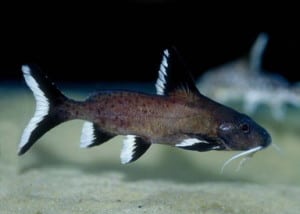
Common name: Synodontis Granulosus
Scientific name: Synodontis Granulosa
Average Adult Fish Size: 10 inches / 25 cm
Place of Origin: North end of Lake Tanganyika in South Africa
Typical Tank setup: Rocky African biotope with ledges, caves, roots/bogwood/driftwood along with some open space.
Recommended Minimum Aquarium Capacity: 120 gallon / 480 litre. May become aggressive in smaller aquariums.
Compatibility: Will eat small fish, best if kept with medium sized hard, alkaline water fish such as medium sized or larger Tanganyikan cichlids. Only ever keep one Granulosus in your tank as they will not get on with each other of you have more than one and will eventually lead to fatalities.
Temperature: 75 – 82 Deg F / 24 – 28 Deg C
Water chemistry: pH 7.8 – 8.4
Feeding: Voracious eater that will accept virtually all aquarium food, but prefers meaty foods such as shrimp and clam. Apparently feeds on small molluscs in the wild. Do not feed worms as it causes bloating, which can be lethal.
Sexing: Both sexes have identical coloration. Females grow slightly larger and tend to be plumper than males. Males have a 4-5 mm genital papilla near the anus.
Breeding: Breeding has been reported by a UK based wholesaler. The breeding pair are kept separate and only introduced to each other in an aquarium for a very short period of time to allow them to breed before being separated again. Actual details of the breeding ritual are currently not revealed. Has also been bred by hormone injection in Eastern Europe.
Additional Information: May jump out of tank in first few days after initial introduction. Make sure the aquarium lid is secure! Main body coloration can range from gray, black, or even beige.
These catfish are always on the move and appear to have a wonderful and extremely inquisitive personality. One of the only fish we have seen swim in to a net when you put it in the tank to see what the net is all about. Be warned though when you put your arm in the tank as the Synodontis Granulosus will nip at any arm hair you have. This doesn’t necessarily hurt and wouldn’t pierce the skin however it is worth being aware of so you expect it and don’t jump when it happens.
Truly stunning colours and although it appears to be just black and white, the white is always sharp and distinct lines are kept between the white on the end of the fins and the dark colours on the rest of the catfish. This fish will definitely stand in the home aquarium and draw a lot of attention to itself with it’s extremely active nature.
The high price tag of the Synodontis Granulosus will hopefully come down as they become slightly more popular and over the last few years they seem to be available in a few local fish stores, although still achieve a normal price tag of over £120! If you are feeling flush though and want a stunning, active and interesting fish then it is worth taking the plunge and picking one up.

Related Posts
Croaking Gourami – Trichopsis vittatus
Paradise Fish – Macropodus opercularis
Schubert’s Barb – Barbus Semifasciolatus